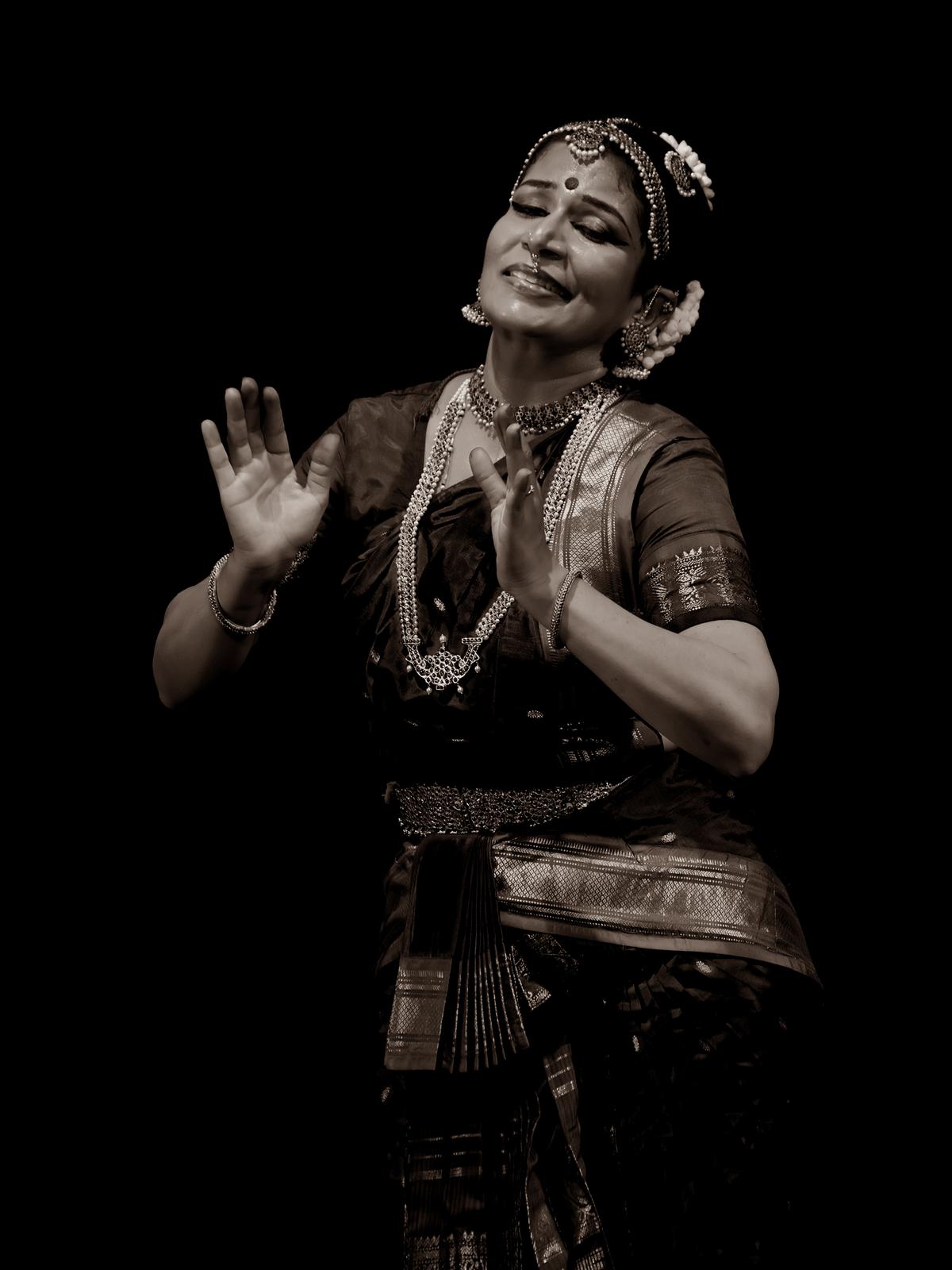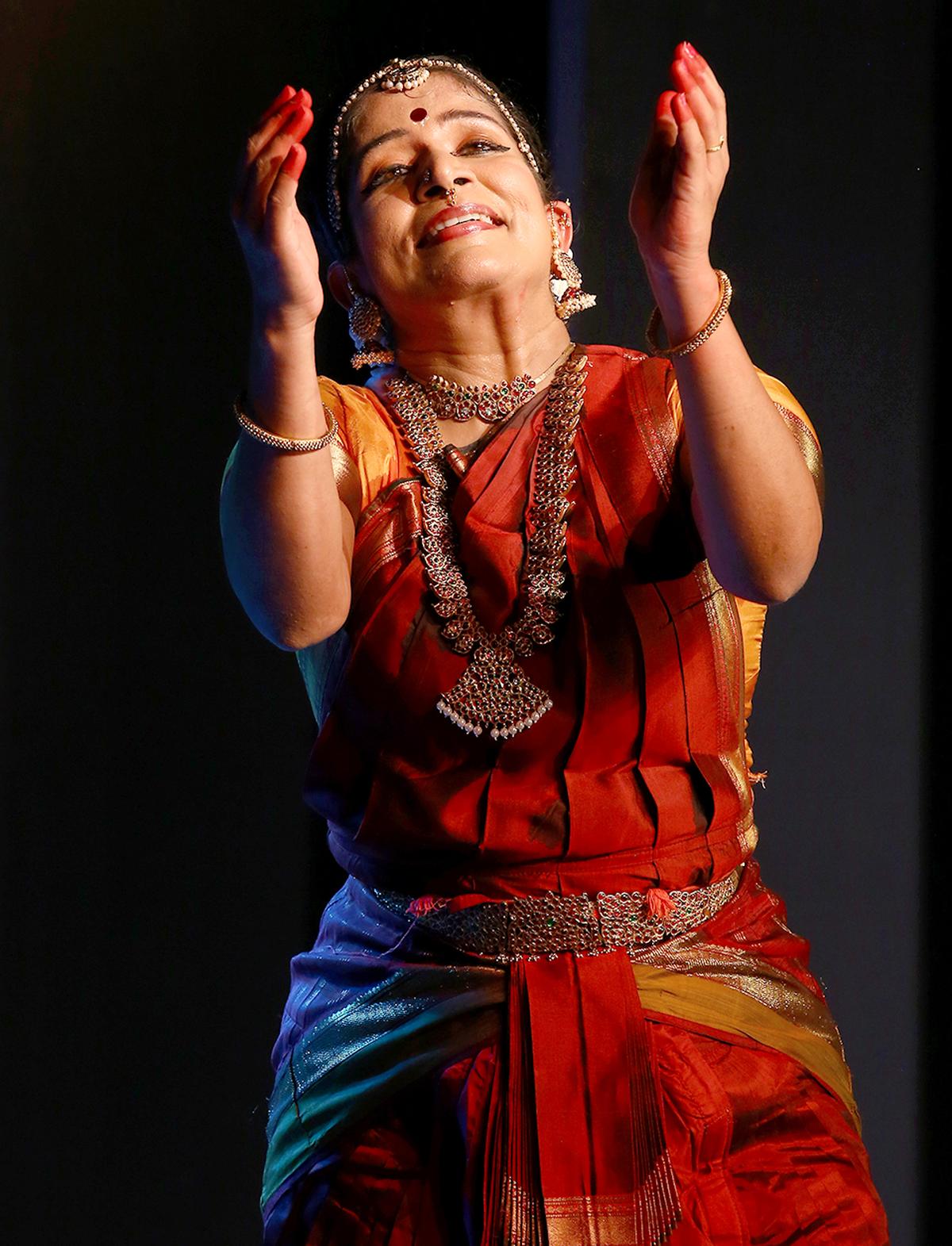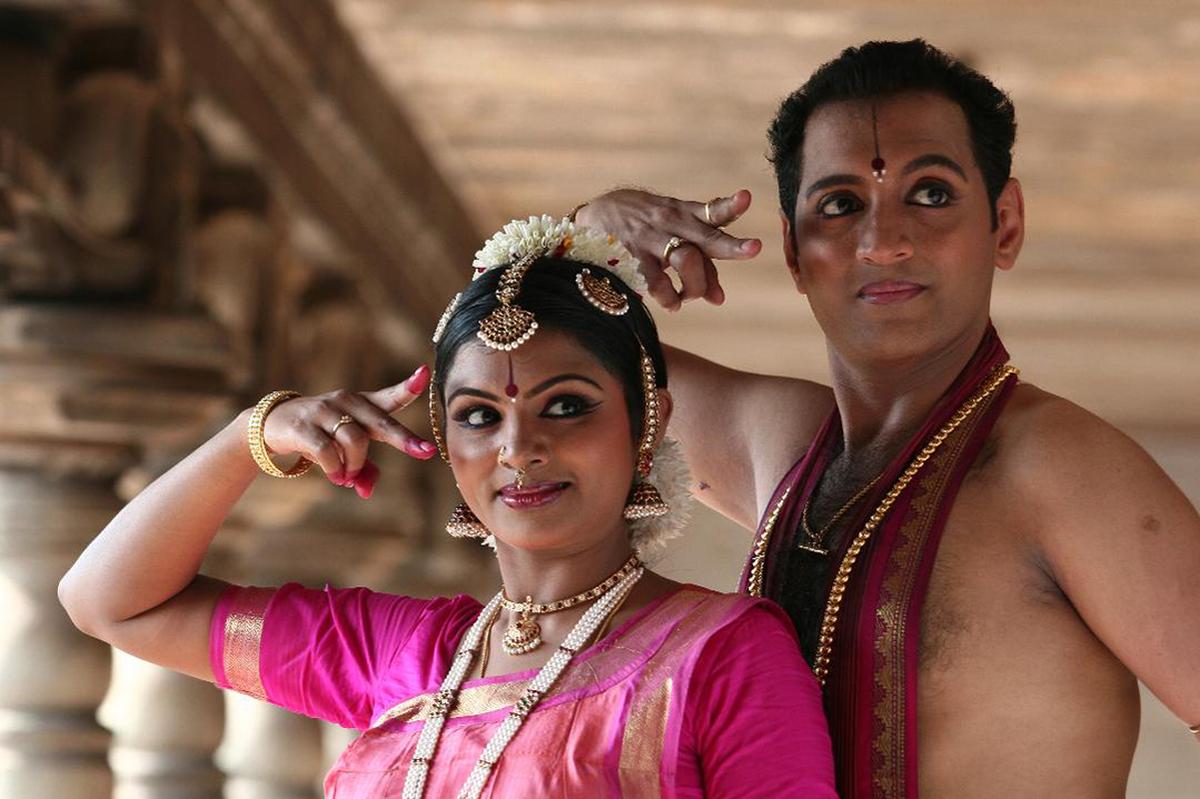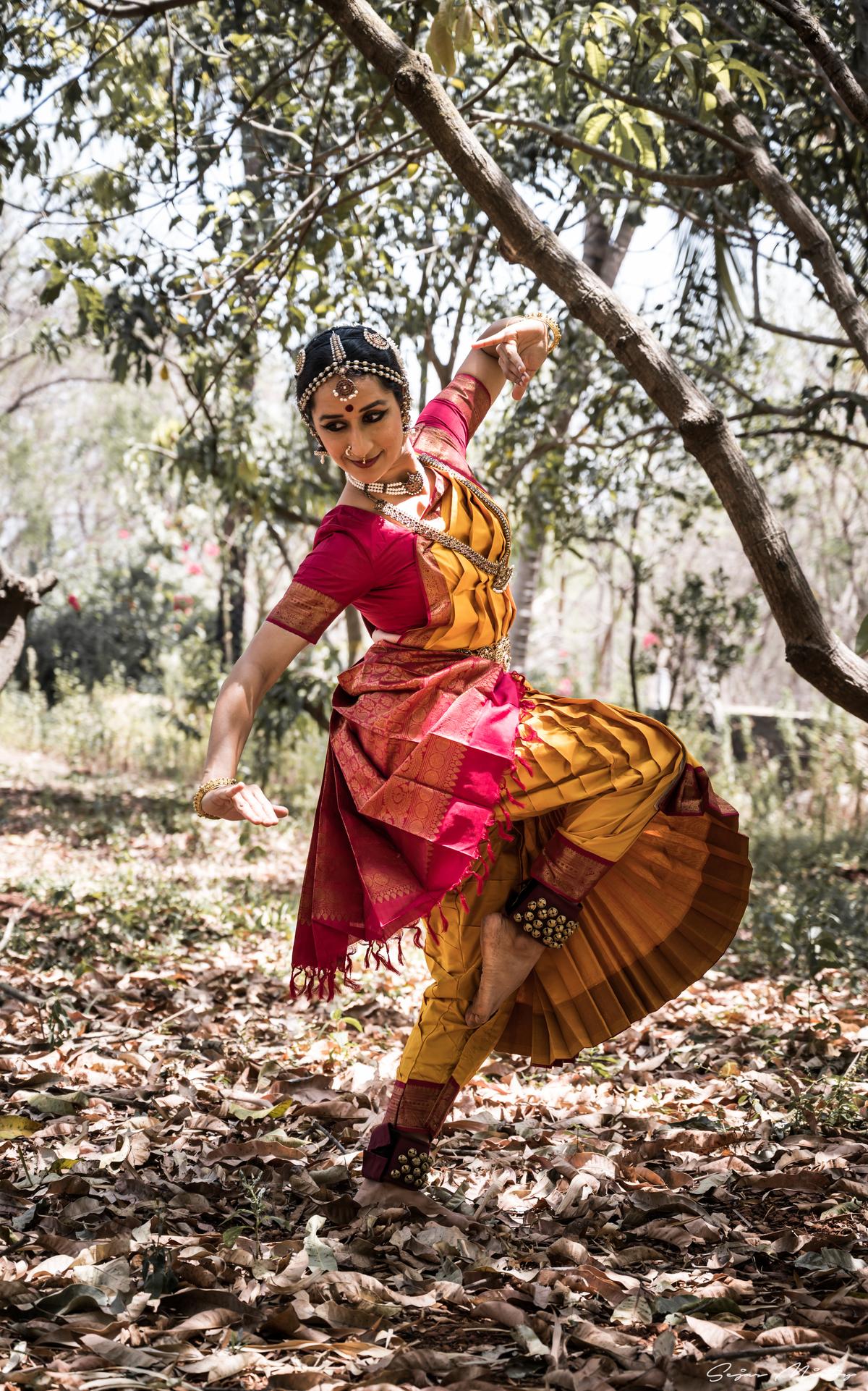On Valentine’s Day, four classical dancers — Navia Natarajan, N. Srikanth, Divya Devaguptapu and Amrita Lahiri write about how they have explored and interpreted Sringara Rasa, the expression of love
Mood and metaphor
Navia Natarajan | Bharatanatyam dancer
“Her lips are fresh red buds,
Her arms are tendrils,
Impatient youth is poised
To blossom in her limbs “
[Shakuntala and the ring of recollection
Translated by Babara Stoler Miller]
When one reads these lines by Kalidasa, one experiences a living, breathing presence of love. This is sringara.
Poetry, sculpture and painting can evoke joy, even exhilaration. Sringara, one of the Navarasas, is layered and profound. To define it in English would be to confine it. While often translated as ‘romance’, it is much more nuanced — it encompasses beauty, longing, passion, separation, sensuality, eroticism and divine love.
Whether in Kalidasa’s works, Jayadeva’s Gita Govinda, Tamil Sangam poetry, or the Amaru Shataka, sringara’s essence is evoked through Nature, emotion, and subtle imagery.
The Khajuraho, Konark and Belur temples stand as some of the finest representations of sringara rasa in Indian art. As artistes, we observe and absorb these impressions, allowing them to settle in our subconscious, only for them to emerge later in the pieces we create.
The Khajuraho, Konark and Belur temples stand as some of the finest representations of sringara rasa in Indian art
| Photo Credit:
SRINATH M
Even early Indian cinema showcased sringara. My choreographies, especially varnams, have been shaped by moments when my mother spoke about the lyrical classicism of certain film songs. For me, sringara is not just about lovers — it is a complete aesthetic experience.
The beauty of many literary verses lies in their openness to interpretation, allowing the reader to find their own meaning. In one of the Amarushatakams (compilation of love poems), four lines capture the subtle yet inevitable drift in a relationship. Seen differently, it becomes a story — of love eroding over time, of silence replacing intimacy. For a performance, I interpreted it as the woman no longer feeling the necessity to stay, recognising the weight of what was lost. With quiet resolve, she chooses to move on, with the clarity that some departures are not endings, but beginnings.

Divya Devaguptapu
| Photo Credit:
Ramanathan Iyer
For the nayika within
Divya Devaguptapu | Bharatanatyam artiste
Sringara is rasa raja (the king of rasas), because love is all encompassing.
In much of the poetry we sing and dance to in Carnatic music and Bharatanatyam, the poets wisely understood that true fulfillment can only be found in journeys that lead inward towards the infinite. The nayika or heroine stands as a symbol for the seeker that exists in us all.
They expressed this wisdom as life being a seeking of the jivatma (soul) longing for union with the parmatma (divine) and the nayika (heroine) a symbol for the seeker that exists in us all.
The feminine is our ability to feel and express emotion (bhava) and the limitation a nayika experiences within is her viraha (separation), and her state of pining. To me, a nayika is the most beautiful metaphor for an emotional state within — for, she is the divine feminine regardless of gender.

Self-love is about complete acceptance of who we are
| Photo Credit:
Special Arrangement
Today, the idea of ‘self-love’ is everywhere. Self-love is about complete acceptance of who we are without judgement. Our vaggeyakaras wrote about this wholeness of life, love and relationships — be it everyday life in humour-laced javalis, or the ultimate love play between the divine feminine (Radha) and divine masculine (Krishna) in the Ashtapadis, or the emotional states of mature relationships in Kshetrayya’s padams.
To truly appreciate and understand our poetry requires surrender and a logic transcending acceptance of all emotions — anger, jealousy, sorrow, despair, fear and more. Though we think we experience love because of another human, our perception of the other is actually our inner experience. Our ultimate happiness or ananda does not happen because of the presence of another, it happens because we find that inner lover within us! And, that is the essence of our poetry, a longing for a union with our lover within.
In today’s world, men and women have been conditioned to analyse everything from a space of questioning and rebellion, rather than feeling.
As a woman raised in the 21st century, I too was subject to this. However, the practice, exploration and becoming various nayikas in these compositions gave me an opportunity to connect deeper with my inner feminine self. To become vulnerable and feel, helping me find wisdom to navigate my relationship with myself with kindness, compassion and acceptance.
For me, the various nayikas are the many emotional states we experience every day. Some days we are ‘Khandita’, on others we are ‘Svadhinapatika’. When we stop hustling, hold space within and feel our emotions, we become the nayika, where there is no morality, judgement or relevance. Only love, inclusivity and acceptance. To me, this is self-love..
Srikanth with wife and dancing partner Aswathy
| Photo Credit:
SHAJU JOHN
Creative bond
N. Srikanth
Bharatanatyam dancer
My early years were spent in Melattur and the summer holidays were packed with Bhagavata Mela training. I started performing when I was six and my first role as heroine (Chandramathi) was at the age of 12. Some plays had characters openly displaying sringaram. My first Bhagavata Mela guru Krishnamoorthy Sarma would teach the Sambhoga/Rati hastas and ask me to copy his expressions. When I could not understand some of them, he would smile and say, “You’ll understand with experience.”
Talking about or explaining those pieces was kind of embarrassing for teachers at that time, possibly because Bhagavata Mela is a ritualistic art form to which a certain amount of sanctity is attached.
As a student of Bharatanatyam, my first guru was a nattuvanar who only taught age-appropriate items. Thus, sringara had to be learnt from life experience.

The Ashtapadi of Jayadeva, ‘Sakhi he’, is a favourite piece of Srikanth and Aswathy
| Photo Credit:
Special Arrangement
Aswathy was first my student and we used to perform together long before we got married. At that time, I used to teach her a lot of Khandita nayika padams. I used to tease her that she’s good at chiding her lover. It is ironical that the sparring hero and heroine later became life partners. After marriage, we began to explore more of sringara on stage and one of our favourite pieces is the Ashtapadi of Jayadeva, ‘Sakhi he’, which we first presented as a duet.
Today, we teach students who have exposure to myriad forms of sringara — from the subtle to the extreme — and it is sometimes difficult for them to relate to the psyche of the heroine/hero who behaves in a certain way. We’re often asked questions as to why she is always waiting for her lover, and why she should send her friend as messenger. If it is an old composition, we cannot tamper with the sensitivities of that era and those characters. To portray progressive thoughts, it is better to choose contemporary poetry.
While performing on stage, our gurus taught us to maintain a certain Oucityam (decorum). The line between vulgarity and sensuality is a very thin one. While this is a matter of subjectivity, we prefer to keep the depiction of sringara subtle on stage.

Amrita Lahiri
| Photo Credit:
Special Arrangement
Saying it through dance
Amrita Lahiri
Kuchipudi dancer
Find me any aspect of love and there will be a dance that can express it. Whether it’s longing, jealousy, unrequited love, telling a friend the details of a clandestine meeting, gossiping about someone’s new romance, or a girl who is not ashamed of her feelings, classical dance has the repertoire and the technique to express it all. Vulnerability is what makes for truly exciting art and that’s most evident in sringara — love.
Sringara is considered the Rasaraaj, and for good reason. There is no rasa more enjoyable to watch and experience, but also as difficult to navigate. After all, art reflects life. Interestingly, the songs of viraha or separation are richer than those about union, or sambhoga.
Padams and javalis are poems that best express every nuance of love. In one, the heroine says, ‘I saw his body glistening like gold in the sunset, when we were alone by the river, and I gave myself to him (Tamil padam ‘Netru veren endre’). In another song, she says, ‘If he comes to my doorstep, I will go {to stand} in front of him, without losing concentration, I will hold his hands, bring him in and make him sit on the bed. With delight, oh my friend, I will keep my bosom on his chest, caress him (from ‘Valapu datsa nerane’ — a Telugu poem by Kshetrayya).
How ironic that the authors of most of these poems are men —Dharmapuri Subbaiyar, Kshetrayya and Jayadeva. They write in a female voice, and one marvels at their understanding and celebration of women’s emotions. Ultimately, gender does not matter, neither in love, nor in art.
There is no rasa more enjoyable to watch and experience
| Photo Credit:
Special Arrangement
In Kuchipudi, love takes on a dramatic and dynamic dimension. Satyabhama, perhaps the most famous of Kuchipudi characters, is the proud but jealous wife of Krishna. Her story is a lesson in giving up one’s ego. She is upset because Krishna favoured Rukmini over her. A similar theme runs through the Gita Govinda, where Radha suffers because of her desire to be the only one with Krishna. In life and love, one learns that the key to joy is to let go.
In dance, there are a multitude of situations of love and imagined lovers. The beloved exists only in our reactions to him.
What is interesting are the nuances of the individual experience of love. Sakhi, the friend, becomes most important. She is the one who is listening to the nayika’s complaints, to her bragging, to her pleading, and to her pain. There is no real hero. The friend is the main partner on this journey for she is the witness and guide in these experiences of love.
Over centuries, this expression has been perfected and elaborated by hundreds of dancers, mostly female, but also some male, who dare to bring the most beautiful and vulnerable emotion onto the stage — love.
Published – February 13, 2025 08:14 pm IST
